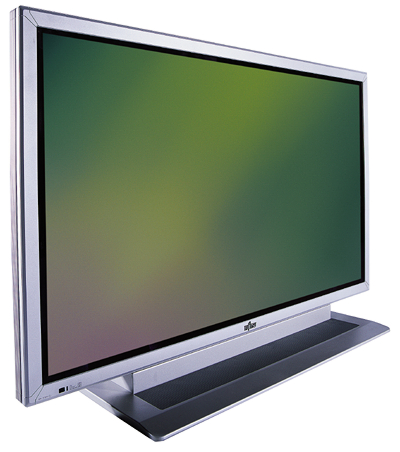Fujitsu Plasmavision SlimScreen PDS-6101 high-definition plasma display

The Quick Tour
Because plasma displays are made up of arrays of individual pixels, they're often called "fixed-pixel" devices. Each pixel is filled with rare gases and contains red, green, and blue phosphors. When the pixel is fired, an electrical discharge excites the gases, which emit ultraviolet light and cause one or more of the phosphors to glow.
Because its pixels are fixed, a plasma is a less flexible display device than a CRT. Any incoming signal must be scaled to fit the native resolution of the plasma's screen, and to accomplish this, all plasma displays include built-in scalers. Fujitsu's Advanced Video Movement (AVM) processor-scaler converts all sources to a 1365x768 progressive-scan image. It also includes a 24-frame mode that recognizes 3:2 pulldown of film-based sources.
The PDS-6101's feature set is nearly identical to that of Fujitsu's PDS-5002 50-inch plasma, which I reviewed in the February 2002 SGHT. The input complement is the same, including a DVI input that's incompatible with the DVI HTCP format supported by several large consumer-electronics manufacturers. The Fujitsu's single set of analog component inputs also means that you must provide external component switching if you have two or more component sources.
The Fujitsu also has three 2-channel audio inputs and a modestly powered onboard amp. But you must supply external speakers to use this feature, which could be useful for casual viewing but is no substitute for a good sound system.
Five screen modes are available with component sources. These accommodate 4:3, letterboxed, and anamorphic program material, as well as modes for placing captions below a letterboxed image, and for stretching a 4:3 source to fill the screen while distorting that image as little as possible. I don't mind such manipulation when watching noncritical material, though Katie Couric did look as if she needs to go easier on the pasta.

One additional mode is available with a composite or S-video input. Auto changes the screen aspect automatically with appropriately encoded program material, but it consistently chose the stretched mode for 4:3 broadcasts. Only the three most-needed modes are available for RGB inputs: Normal (4:3), Wide (anamorphic), and Zoom (letterbox).
All of the PDS-6101's operating controls are accessible, if somewhat awkwardly, via buttons at the underside bottom left of the screen frame. But most often you'll do everything from the remote, which, while not illuminated, has few buttons and is easy to use by feel in a darkened room.
The picture controls are selected from onscreen menus. There you'll find the standard video adjustments as well as Gamma, Noise Reduction, and Color Temperature. Each of these can be tailored for each input, and the settings are designated by numbers, making them easily repeatable (assuming you've written them down). After the PDS-6101 had been properly calibrated, I found that the Fine setting of the Gamma control produced the most natural-looking image. Video Noise Reduction was seldom needed. Color Temperature, which offers Warm, Standard, Cool, and User settings, was set as described in the "Calibration" sidebar.
An important note: As with the 50-inch PDS-5002, you must press Enter to save any changes you make in the menu settings. If you don't, the change will revert to the previously saved values as soon as you back out of the menu.
Like all plasmas, the PDS-6101 is a power hog, only more so: It's rated at 7.5 amps. In addition to the impact on your electric bill, you must ensure that any circuit you connect it to can take the load. I wouldn't expect a problem with the typical 15-amp house circuit, even with the rest of a home-theater system of average power requirements connected.
But there's one significant byproduct to a high power draw: heat. Like most plasmas, the Fujitsu runs hot, and therefore has cooling fans. Some readers complained about fan noise from the 50-inch PDS-5002; while I wasn't bothered by it, the PDS-6101's fans were clearly audible in a quiet room—or even with low-level audio playing. I lived with the set for several weeks in a relatively small room (roughly 17 x 13 feet), and while I found its fan noise no more intrusive than the quiet moan of the refrigerator in the open kitchen adjacent to the evaluation room, your annoyance threshold for this sort of thing might well be different. It's worth searching out a quiet showroom to judge the noise for yourself.
- Log in or register to post comments








































